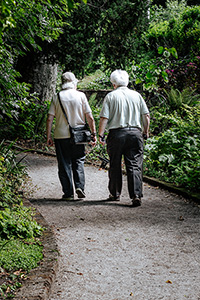“An early-morning walk is a blessing for the whole day.” -Henry David Thoreau
Walking is such a great exercise option for everyone, but especially for older adults. It quickly improves mood, health and well-being in so many ways. It can also help seniors live independently longer. Among the many benefits of walking are:
- Strengthening muscles
- Maintaining a healthy weight
- Lowering risk for heart disease, stroke, diabetes and even some cancers.
- Strengthening bones to prevent osteoporosis and osteoarthritis.
- Reducing blood pressure in those with hypertension
- Improving balance and coordination (which decreases fall risk)
- Keeping joints flexible
- Increasing confidence and mood
- Contributing to an overall sense of well-being
- Improving energy levels
- Increasing stamina
- Reducing anxiety or depression
- Improving social life (if you’re walking with a friend or meeting new friends when you walk)
As you can see, it’s quite an extensive list for such a simple activity! Maintaining the ability to walk without help is one of the strongest indicators of whether someone can live safely on their own. Older adults that exercise regularly and take daily walks are less likely to need assistance doing things for themselves around the house. Especially for seniors, exercise does not need to be long or strenuous to be effective. Walking at a steady pace for 20-30 minutes or walking up and down hills or in shorter, quicker bursts are all excellent ways to get health-boosting exercise every day.
Check with your doctor.
Before you begin any exercise regimen, it’s always important to check in with your doctor about activities to avoid and safety precautions to take. This is especially true if you haven’t exercised for a while. Here are some questions to ask before you begin a walking routine:
- Is there anything I should avoid while walking (hard surfaces, loose gravel, etc.)?
- Could anything in my medical history affect how I exercise?
- How can I exercise safely if I have high blood pressure, diabetes or cardiovascular disease?
- How should I start my new exercise routine safely?
- How can I manage pain from sore muscles and/or arthritis as I ease into an exercise routine?
If your doctor voices any concerns, ask how you can safely begin this exercise program or if there are other exercises recommended as an alternative (such as water aerobics). If you develop any of the following symptoms after beginning a new routine, you should see your doctor again right away:
- Dizziness
- Chest pain
- Shortness of breath
- Rapid weight loss
- Sores that don’t heal
- Pains in your body that don’t go away
If any of these symptoms arise, discontinue exercise immediately until you’ve had a chance to see your doctor.
Get the proper equipment.
Make sure you wear the correct shoes for walking. This will mean comfortable walking shoes that fit well and offer the right amount of support to prevent injuries. If you have issues with your feet, you can also discuss this with your doctor or podiatrist. There are some shoe stores that do free evaluations of how you walk to recommend the best shoe for you. Don’t be afraid to walk with a cane or walker. They can improve your balance and help your joints ease into the exercise better.
Find a walking partner.
Make your walks more enjoyable and memorable by walking with a friend or loved one. It helps make the walks easier and makes you look forward to it every day. You’re less likely to cancel on a friend or loved one. It’s also safer to go out walking when you have someone with you for many reasons. Even if no one comes to mind when you think of finding someone to walk with, you can always search in your local area for a walking group that would provide all the same benefits. ————————– Want to learn more about senior living at its finest? Give our team of care professionals a call today to chat about your options.



